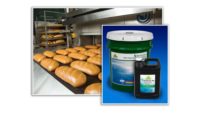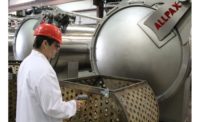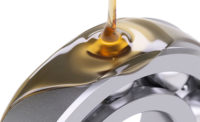Supplier's Perspective: NSF
Avoiding the risk of recalls with food-grade lubricants
Selecting products that have been independently verified for safety is one way to reduce risk.

Every day, food and beverage manufacturers rely on a wide range of chemicals, such as food-grade lubricants, to aid in the manufacturing process. Today, the use of chemical compounds has become so common that many of us don’t think twice about our interactions with them. When chemical products are used in food processing, it’s important that the manufacturer clearly understands each product’s intended use and limitations. Failing to do so can result in significant consequences. In fact, the use of non-food grade mineral seal oil recently led to a recall, posted on the US Department of Agriculture Food Safety and Inspection Service website. Due to the use of the oil, more than 90,000 pounds of raw meat was recalled.
As recent recalls have demonstrated, the improper use of these chemicals, whether purposeful or unintentional, can result in significant financial and reputational damages to the manufacturer. To reduce the likelihood of contamination, food manufacturers worldwide are increasingly using nonfood compounds that have been independently verified to meet the requirements for use in food applications.
What are nonfood compounds?
A nonfood compound is a composition of ingredients combined to form a product that is intended to be used in food and beverage processing facilities. These compounds are designed to aid in the manufacturing process but are not intended to be added as an intentional ingredient of food. Examples of nonfood compounds include products intended for cleaning, sanitizing, pest control and lubrication. As an independent, ISO 17065-accredited body, NSF evaluates a wide range of chemical products for food safety under its Nonfood Compounds and Chemical Registration and Certification program. The program is based on a detailed evaluation of the formulation. Each ingredient within the composition must meet a set of criteria which is based on the intended end use. For example, lubricants that may have incidental contact with food, often referred to as “H1” lubricants, must meet the formulary requirements of the Food and Drug Administration (FDA) 21 CFR, section 178.3570.
What are some of the considerations meat and poultry processors should consider?
While the use of registered products can provide some guardrails, food manufacturers must ensure that additional procedures are in place to reduce the risk of contamination of their food products. These procedures are typically outlined in a systematic preventative control process such as a Hazard Analysis and Critical Control Points (HACCP) plan. These plans are intended to identify and mitigate risks in the manufacturing process. As part of these controls, food manufacturers should ensure careful consideration of the chemical products being introduced into their facility. Selecting products that have been independently verified for safety is one way to reduce risk. Continuous training of staff can also aid in this goal by ensuring that the registered products are being used as intended by the manufacturer.
What are some of the recent trends/innovations in food grade lubricants?
In addition to the Nonfood Compounds registration, leading manufacturers of food-grade lubricants have elected to demonstrate an enhanced level of safety by certifying their products to ISO 21469. This global standard includes a formulary review that is similar to H1 lubricants but goes a step further by requiring a thorough risk assessment of the manufacturing facility, along with an audit of each facility to ensure that the manufacturer is following all safety precautions. The standard also requires product testing to manage consistency throughout the manufacturing process.
How else can meat and poultry processors ensure food safety?
Food manufacturers have a great responsibility when it comes to food safety. Ensuring that the proper chemicals are procured and utilized appropriately is a critical step of any safety plan. Ultimately, a strong culture of safety within the manufacturing facility is the best approach to reduce the likelihood of a costly recall.
Looking for a reprint of this article?
From high-res PDFs to custom plaques, order your copy today!










